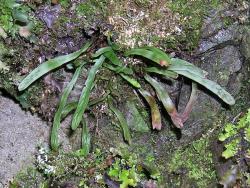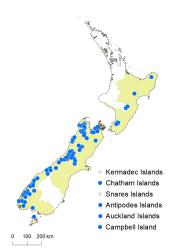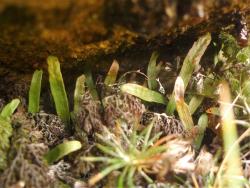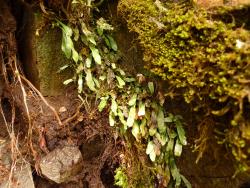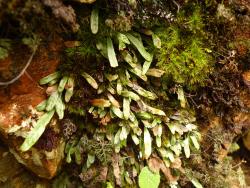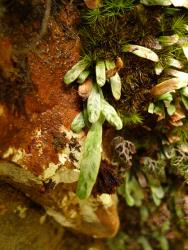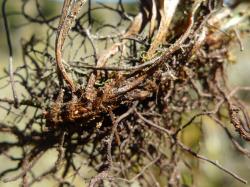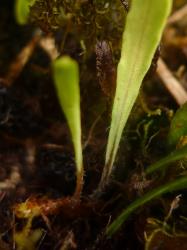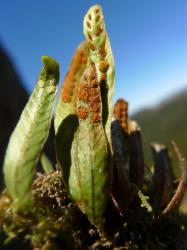- Taxon
- Gallery
- ≡ Grammitis givenii Parris in Parris & Given, New Zealand J. Bot. 14: 96 (1976)
Rhizomes short- to long-creeping, bearing scales. Rhizome scales ovate to narrowly ovate, 1.5–5.5 mm long, 0.3–1.5 mm wide, pale brown, concolorous, non-clathrate. Stipes 1–25 mm long, black or dark brown, usually distinct, not winged, ± glabrous to hairy. Stipe hairs sparse to abundant, white to pale red-brown, 0.2–2.0 mm long. Fronds undivided, narrowly obovate to obovate, 9–115 mm long, 3–12 mm wide; apices acute to obtuse; margins entire; bases attenuate to a distinct winged stipe; both surfaces pale green; coriaceous; glabrous or bearing occasional hairs up to 1 mm long on the costa. Hairs either setae, or branched hairs with setiform branches. Hydathodes usually absent or rarely present. Sori subglobose to elliptic, elongated along veins, oblique, 3–7 mm long, in 1–10 pairs in upper half of lamina, lacking hairs. Sporangia 170–350 µm long; spores 25–52 µm diameter.
Notogrammitis givenii is characterised by its usually long-creeping rhizomes, clearly defined and hairy stipes, obovate fronds, and lack of hairs in the sori. It is similar to N. gunnii and N. patagonica, but is distinguished by its lack of hairs on the lamina surfaces and margins, and in the sori. The alpine species, N. crassior, has a much smaller frond (4–42 mm long, 1–5 mm wide; cf. 9–115 mm long, 3–12 mm wide), and is usually glabrous. N. givenii can also be mistaken for N. billardierei, but the latter generally has an erect or short-creeping rhizome, indistinct stipes, narrowly elliptic rather than obovate laminae, and longer fronds (20–245 cf. 9–115 mm long).
North Island: Volcanic Plateau, Gisborne, Southern North Island.
South Island: Western Nelson, Sounds-Nelson, Marlborough, Westland, Canterbury, Southland, Fiordland.
Chatham Islands, Stewart Island, Antipodes Islands, Auckland Islands, Campbell Island.
Altitudinal range: 150–1700 m.
Notogrammitis givenii is rare in the North Island, known only from subalpine and alpine populations in the Raukūmara, Huiarau, Ruahine and Tararua Ranges, growing from 1200 m to almost 1550 m. In the South Island it occurs in alpine and subalpine habitats from north-west Nelson to Fiordland, ranging from 600 m in Fiordland to 1700 m on Aorere Peak, north-west Nelson. It also reaches the Chatham Islands, where it has been collected at 250 m, and the subantarctic islands, where it descends to 150 m on Campbell Island.
Notogrammitis givenii is found in montane podocarp and broadleaved forest, silver and mountain beech forest, subalpine scrub, tussock grassland, and alpine herbfield. It grows on damp rock bluffs, on boulders, in rock crevices and sinkholes, and under overhangs on a variety of rock types including basalt, greywacke, granite, schist, gabbro, limestone and marble.
Specimens from the subantarctic islands (Antipodes Island, Auckland Islands and Campbell Island) differ in some respects from those of more northern locations (North, South, Chatham and Stewart Islands) in having shorter and sometimes glabrous stipes, and smaller fronds. WELT P027507, from Antipodes Island, has rbcL and trnL-trnF sequences identical to those of New Zealand N. billardierei, but very different morphology, with rhizomes more widely creeping and stipe hairs, if present, not as dense.



